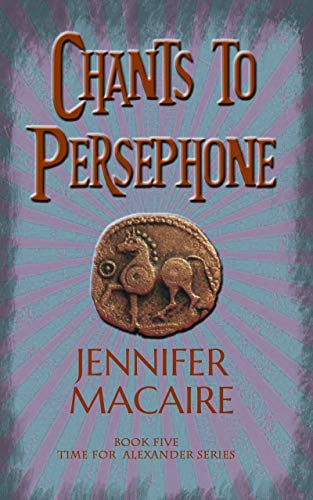
by TCW | Nov 13, 2018 | Book review
In “Chants to Persephone”, the latest book in her “Time for Alexander” series, Jennifer Macaire talks about the forerunners of the Vikings with horns on their helmets.
It’s an interesting bit of period detail because everybody knows, as we are told over and over again, that the idea that Vikings wore horns on their helmets is a myth. Except that I had a definite recollection of seeing a horned helmet at the Museum of London, so yesterday I went and took a photo.

It turns out that this is not the original piece, but a copy. The original is in the British Museum and I reckon that the Museum of London knows how to make a decent copy. At least, it’s unlikely that they put the horns on by accident.
The helmet dates from between 150 and 50 BCE, so it’s a couple of hundred years after the one that Jennifer Macaire is describing, but it fits nicely the pre-Viking period she is writing about. This one is unlikely to have been worn by the ancestors of any Norwegians, given that it was found in the Thames at Waterloo Bridge, but it does show what the well-dressed warrior was wearing in this period. The label says that it was “unlikely to have been worn in battle”, but was probably a religious offering. I’ve read this about other horned helmets, but the only evidence for it seems to be that we all know that the Vikings didn’t wear horned helmets, so all the horned helmets we find must have been purely ceremonial. It’s a bit of a circular argument.
This does illustrate the difficulty in writing about this era. Jennifer Macaire’s books are full of detail. Some of the detail – even stuff like how the ancient Greeks made toothpaste – is carefully researched from written records, but “Chants to Persephone” takes her time travelling heroine to ancient Gaul and written records there are thin on the ground. The result is that a lot of the detail is more speculative than in the earlier volumes. For example, Ms Macaire tells us that
Breakfast in Gaul consisted of bacon, porridge with honey, scalded milk with chicory, eggs, and a delicious sausage made over of leftover wild boar fried with spices.
How does she know? Have we unearthed an Ancient Gaulish fast-food joint complete with breakfast menu?
In fact we can make reasonably educated guesses about what the Gauls ate, supplemented (I’d guess) by written records once the Romans arrived. Bacon, honey, porridge – all these seem reasonable things for the Gauls to eat, but did they eat them for breakfast? I have no idea – and I’m guessing that Macaire has no idea either. But they are reasonable assumptions based on what evidence we have and even if the details are wrong, I think that “Chants to Persephone” gives a fair idea of what life in Gaul must have been like.
This is the wonder of historical fiction: it allows us to explore the past, using our imagination to fill in those pesky gaps in the historical record and Macaire does it in her usual engaging style.
This book marks a turning point in the series, because up till now it has been rooted in what we know of the history of Alexander’s life. Anyone who’s been following the story so far (and if you haven’t, I’d recommend you read the first books rather than start with this one) will know that the time-travelling Ashley has saved Alexander from malaria, leaving a convenient corpse to take his place in history. Macaire has taken Ashley away from Babylon (where the real Alexander died) and she is now travelling through Gaul with her Macedonian hero. The plot, to be honest, is a bit sketchy and much of this episode in the continuing series is travelogue, spiced up with a fair bit of violence, Macaire’s trademark humour, and Ashley’s rampant sexual appetite. (We have a brief lesbian episode in this book, which Ashley at least has the good grace to feel embarrassed about — though why she should be embarrassed given her husband’s flagrant bisexuality is not entirely clear.) If you’ve enjoyed the books so far (and I have) you will enjoy this one – though maybe not as much as some of the earlier episodes. If you haven’t met Ashley and Alexander yet, I really recommend that you do, starting with “The Road to Alexander”.
And, just for good luck, here’s a shield to go with that splendid helmet.

Chants to Persephone is available on Amazon: getbook.at/Persephone

by TCW | Nov 6, 2018 | Book review
It’s Tuesday, so time for another Tuesday book blog. Endeavour Media (my own publishers) are republishing the Dr Morelle books from the 1940s and 50s and I’m going to write about these.
I’m a big fan of old-school detective stories (though I personally favour the 1930s when Simon Templar – the Saint – was at his buccaneering best) and I find these strangely fascinating. Partly it’s that Dr Morelle is a wonderfully inappropriate hero. He’s arrogant and rude and continually belittles his assistant, the mousey Miss Frayle. He’s a dark, brooding presence (the author, Ernest Dudley, rather over-uses ‘saturnine’ when describing him). Yet his heart is in the right place and he can be relied on to solve the crime, save the innocent and see the guilty brought to justice.
They are odd books. They are far from the Agatha Christie school of whodunnit, with Morelle often spotting key evidence that he slips into his pocket without Miss Frayle or the reader being able to catch a glimpse of what it is. Nor are they really thrillers, because there is a notable absence of tension. In Dr Morelle and the Drummer girl Miss Frayle is captured, tied up and lodged in a hidden room. We never have any doubt that she will be rescued. Morelle (in the stories I’ve read) is never personally threatened and if he were he would obviously overcome his assailant with the sword stick he carries. He is, after all a three times European fencing champion.
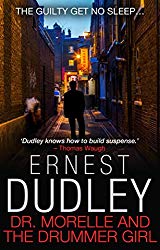
What’s the appeal? Morelle is consciously modelled on Sherlock Holmes (he even lives in 221B, though as a doctor he inhabits Harley Street rather than Baker Street). He is a human calculating machine, telling poor Miss Frayle that “it is only by a process of skilled ratiocination that the truth can be arrived at”. Dr Morelle is essentially another incarnation of Sherlock Holmes, whose iconic status was the subject of last week’s book blog.
The plots aren’t as clever as Conan Doyle’s but the relationship between Miss Frayle and her employer is subtler and more interesting than that between Holmes and Watson and the 1950s atmosphere is a treat. How can you not love a story which features a character called Aces La Rue?
by TCW | Oct 30, 2018 | Book review
Unquiet Spirits by Bonnie MacBird is a detective story set in 1889. It features suitably evil villains, a Scottish castle, a beautiful woman of mystery and possibly a ghost. It’s a jolly good read and I’ll happily recommend it to anyone who thinks that a book matching that general description is the sort of thing that might appeal.
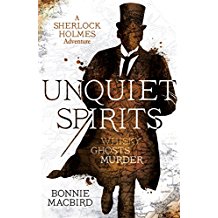
It also features a detective called Sherlock Holmes. Does that make it any better than it would be anyway? Arguably not, but MacBird is riding a wave of Holmesian re-writes. Perhaps it is worth asking what distinguishes all these books and why they remain so popular.
In the past few weeks I’ve read three: this one, The House of Silk by Anthony Horowitz and Sherlock Holmes: The Adventure of the Primal Man by Derrick Belanger. There are many, many more with, as it were, ‘spin-offs’ like Laurie R King’s Mary Russell series, featuring a young girl who becomes the older Holmes’s protégé. And, though it’s a TV series and not a book, we can’t ignore Benedict Cumberpatch’s brilliantly presented re-imagining of the great detective in Sherlock.
Some of these writers go to great pains to capture the ‘voice’ of John Watson. Anthony Horowitz, in his essay on writing The House of Silk (which now appears in the paperback) says how important it seemed to him to get that voice right and I certainly felt I was reading something very close to the original. MacBird, by contrast, doesn’t read remotely like John Watson and neither does Belanger, who happily has Watson put the word ‘trash’ into Holmes’s Victorian mouth. King gets round the problem by writing not as Watson but as Mary Russell, which works well but means that there is no possibility of mistaking the books for anything Doyle might have written.

The fact that most Holmesian homages don’t read at all like the originals does not detract from their popularity and, though purists may carp, it doesn’t really spoil Unquiet Spirits. So, if the narrator’s voice (or, with King’s books, the narrator) isn’t what matters, what does?
Is it the character of Sherlock Holmes himself? Possibly. But what do we mean by the ‘character’ of Holmes? In this post-Trainspotting era, both MacBird and Horowitz make a point of having a drug-free hero and Belanger goes so far as to have had Holmes take up meditation in Tibet to explain the absence of drugs in his story. Holmes was always physically fit, but MacBird has him leaping “gazelle-like” over the furniture in his flat, which seems unlike the more cerebral figure that Doyle’s Holmes usually cuts at home. When I close my eyes and think of MacBird’s Holmes, I must admit I see Benedict Cumberpatch.
Arguably, it is not the physical manifestation of Holmes that draws us to such stories. Isn’t the most important thing watching the deductive powers of the “human calculating machine” at work? Horowitz presumably thinks so: he provides several examples of the parlour tricks that Holmes loves to play on visitors.
“I can tell that you have just returned from Holburn Viaduct. That you left your house in a hurry, but even so missed the train. Perhaps the fact that you are currently without a servant girl is to blame.”
MacBird offers fewer of these coups de theatre and, when Holmes attempts them, he is often proved wrong. (Even Horowitz has him make the odd mistake: the 21st century is much more sceptical of genius than the 19th.) MacBird, I think, does herself no favours by cutting back on this element of the original books. They are fun, and part of the definition of the genre, but they are clearly not absolutely essential to Holmes’s character.
So what is the essence of Sherlock Holmes?
Oddly enough, I think the clearest contemporary comparison is with Batman. Batman was first introduced to the world in Detective Comics in 1939 and is often referred to as “the greatest detective”. More importantly, though, he is not a super-hero, but a man who has achieved greatness by rigorous training and commitment to his cause: fighting crime and destroying evil. He has thus reached almost super-human standards of excellence in his crime-fighting role. He has a tragic past and is now isolated from most regular social interaction, except with his side-kick, Robin, and his butler, Alfred, who attends to his practical daily needs. He has no meaningful relationships with women and his past is shrouded in tragedy.
Holmes, like Batman, appeals because he represents what humans can achieve by sheer application. He has become great, reaching standards of analytical reasoning that appear almost magical. This almost mystical persona is enhanced by the fact that he has no regular social relationships and we see him through the prism of his faithful side-kick, Watson. He doesn’t have to worry about his practical daily needs, because these are met by Mrs Hudson. He has no meaningful relationships with women and his past is shrouded in tragedy.
Both Batman and Holmes have attained almost mythic status in their respective literary worlds, because the figure they represent touches on a Platonic ideal of the ideal man (and both figures are men – female Bats and Holmes are occasionally imagined but never threaten the original). Human, yet separated from common humanity, born out of tragedy and doomed to an isolated existence, dedicated to serving the common good, Holmes, like Batman, is a mythic archetype.
MacBird’s Holmes measures up in many ways and she devotes a significant part of the story to probing his tragic past. On the one hand, this builds on the myth by confirming what we all suspected: Holmes’s past was, indeed tragic. On the other hand, by spelling out the details, some of the mythic element is lost. Holmes is no longer some sort of uber-mensch forged from tragedy, but a rather sad and solitary individual who has never recovered from the murder of his first love. Holmes’s back-story, although woven into the main narrative, isn’t necessary and, far from making Unquiet Spirits a seminal part of the Holmesian canon, it detracts from the traditional view of the great detective.
Horowitz seems more assured. As with Doyle, Holmes is front and centre of the story, his character always observed through the often adulational eyes of the trusty Watson. His Holmes is always more weighed down by his failure to protect everyone whose paths he crosses than it is buoyed up by his successes. He is a tragic figure rather than (as with MacBird’s Holmes) a figure shaped by a specific tragedy.
Belanger’s Holmes is hardly tragic at all. The hero of The Adventure of the Primal Man is just a very clever man who shares Holmes’s name and address but adds nothing to the canon. It’s a lightweight piece compared with House of Silk or Unquiet Spirits, but it represents the way that Holmes keeps popping up in contemporary literature when an author needs a great detective and a period setting. They don’t develop the character of Sherlock Holmes, but may be no less entertaining for that. And at least Belanger hasn’t given Holmes a girlfriend.
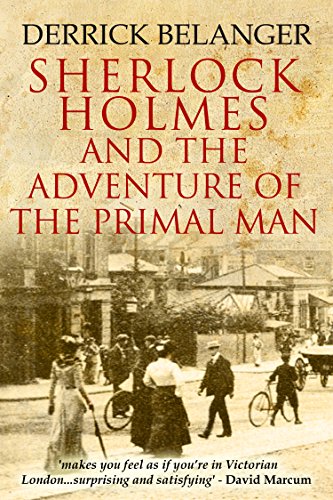
Holmes, then, turns up in contemporary literature (not to mention films and TV) in a variety of guises ranging from a careful recreation of Doyle’s hero to a generic Victorian, or early Edwardian, detective, to a reimagining for the 21st century (possibly complete with bat costume). What is the appeal? It’s not Doyle’s literary genius. The stories are well-written and workmanlike, but Doyle himself despised them, hence the Reichenbach Falls where he tried to put an end to the character once and for all. (Doyle thought his literary heritage would be a series of historical novels set in the 14th century. They were quite popular, but have not stood the test of time.)
In the end, Holmes represents certainty: the triumph of good over evil by the application of rational thought. He is a god-like figure for a scientific age. Born in a time when people believed, apparently with good reason, that the problems of the world could be solved by scientific progress, he has become, paradoxically, more popular when the most casual glance at a newspaper suggests that the world’s problems are insoluble. We need to believe that out there somewhere there may be somebody who can apply his mind to any problem and come up with an answer that is not only correct, but has been obtained by a process of rational reasoning. Holmes always gets the answer by logic, rather than luck, and Watson – representing us mere mortals – always spells out the details of Holmes’ reasoning so that we can see that no magic has been involved.
Ironically, Doyle himself believed in spirits and was taken in by the most amateur of faked photographs of fairies. Those who know his life story may feel sympathy (his belief in spiritualism was driven by the loss of his son in World War I) or we may mock. But in either case, we are likely to cling all the harder to the philosophy of Rationalism and seek out another story based in the extraordinary powers of the mind of the Great Detective.
This article first appeared on the website of the Historical Novel Society.
by TCW | Oct 16, 2018 | Book review
I read this book a couple of years ago and loved it, but the author was remarking on Facebook the other day that it has sunk without trace. She’s upset, because it was a personal favourite of hers and I agree with her that it deserves better. So I’m re-posting my review in the hope that some of you might decide to read it.

After exploring the middle of the 19th century with last week’s review of Fingersmith, this week may seem hardly historical at all. S.A. Laybourn’s A Kestrel Rising is set during World War II. There’s no doubt that stories set in the 1940s qualify as ‘historical’ but many people see ‘war stories’ as a separate genre. This, though, is no war story: it’s a romance told from the point of view of a young woman (Ilona) who has joined the WAAF to do her bit for the war effort by driving. She starts by driving pilots to their aircraft and she is soon adopted by the absurdly young men that she takes out to wait for what might be their last flight and who she greets as they return, frightened but putting a brave face on their adventures. Romance almost inevitably ensues, but then this idyll (he is handsome and kind; she is a virgin, desperately giving herself to the love of her life) ends with the death of the pilot. Around a fifth of ‘the Few’ died in the Battle of Britain and the book is very good at capturing the way that everyone in the RAF and WAAF had to live with the reality of friends and comrades dying or being horribly injured on a regular basis.
Ilona is emotionally destroyed by the loss of her lover and transfers to a job driving trucks between RAF bases, so she has less contact with the pilots. The war, though, touches every aspect of her life. Her family is terribly important to her but she hardly ever has the chance to visit them. So when it turns out that a distant relative has come over from America to sign up with the RAF, she feels obliged to spend time with him. In one of the book’s rare descents into cliché, she at first hates him before slowly growing close to him. But he is flying escort in the bombing raids on Europe – a role with a horrifically high attrition rate. Ilona is terrified to admit her feelings because she feels that she cannot face the loss of a second lover.
I would say that this is very definitely a ‘historical novel’. The romance is defined by the reality of war and the social attitudes of its time. It’s probably more driven by historical reality than most ‘historical romances’ where, one suspects, the details of the dresses are the only point at which real history touches the story. Here everything from the ring that her lover gives her to wear on their ‘dirty weekend’ to the impossibility of sleeping together when he visits Ilona’s house (though her parents are under no illusions as to their relationship), all catch the combination of social repression and sexual liberation that seems to have typified the war years.
Laybourn also writes with real understanding about the emotional agony of losing a lover to death. It’s probably only fair to say that I have been a ‘virtual friend’ of this author for a while (though I have never met her) and I know that these passages reflect her own experience. They are written from the heart and rise far above the mawkishness that can characterise some romantic writing.
While this is a romance, rather than a war story, Laybourn has a scarily precise grip on the different sorts of fighter planes used in the war and the various ways in which you could die in all of them. When the pilots describe their experiences, they ring absolutely true. There’s also interesting stuff about the position of US airmen as the US finally joins the war.There are, of course, places where reality gives way to the necessities of keeping the plot moving. Realistically, there are an awful lot of railway journeys (the only way to travel any distance when off-duty) but, unrealistically, our hero and heroine always get seats, so they can move the story along with meaningful conversations. While it is remarked on as lucky, accounts I have read of wartime travel suggest it was little short of miraculous. And once the war is over, everybody is demobilised practically overnight so that Laybourn can hurry us to the inevitable happy ending. (I was holding out for a dark twist where they survive the war only to die in a freak motorcycle accident on the first day of peace, but I’m not your average romance reader and it was never going to happen.) There are an awful lot of goodbyes at stations (I felt sometimes that I was on a constant rerun of ‘Brief Encounter’) but that’s probably realistic and if the desperately stiff upper lips and ‘I do love you, darling’s seem ridiculous in 2016, I doubt they did back then. The one occasion where they take a return rail journey and end up back at a different London terminus is less convincing, but perhaps the usual route was blocked by bombing or something. It’s the only obvious ‘gotcha’ so I’ll give it the benefit of the doubt.
Beautifully written, with credible characters you come to care about, this book works as a romance and as a novel of the Second World War. I recommend it.
by TCW | Sep 11, 2018 | Book review
I’m a big fan of crime stories. To admit to enjoying Colin Dexter or Lee Child doesn’t have the same social cachet of claiming to be half way through Proust, but crime novels are immensely popular. They are also surprisingly difficult to write well.
Recently, thanks to the generosity of NetGalley, I’ve had two more whodunnits to read. The first, The Mystery of Three Quarters, is an absolutely classic British example of the genre. It’s the latest of Agatha Christie’s Hercule Poirot stories. It’s not actually by Agatha Christie of course – she died in 1976 – but by Sophie Hannah, who is now regularly turning out more books to continue the franchise. The other is from Norway – The Katharina Code by Jorn Lier Horst.
The two stories are very different, yet they share a great deal. The Katharina Code has some elements of a police procedural. A cold cases review team is focusing in on their prime suspect. The detectives are all professionals, using the resources of the Norwegian police to keep surveillance on a man suspected of two separate murders, many years apart. Agatha Christie’s Poirot, by contrast, acts almost entirely as a private individual although he is helped in the mechanics of his business by an Inspector Catchpool of Scotland Yard. (Sophie Hannah has set her story late in Poirot’s life, so the ever-reliable Jupp from Christie’s books is now presumably too senior to do Poirot’s legwork. I did miss him, though.)
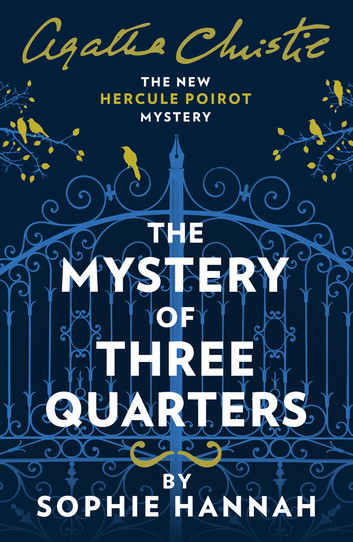
Both stories claim to show the detective solving the crime by analysing and playing on the psychology of the suspects. Poirot always claims that it is human psychology that is important in finding the criminal. In the first book he features in – The Mysterious Affair at Styles – he goes so far as to praise the importance of instinct:
“Instinct is a marvellous thing,” mused Poirot. “It can neither be explained nor ignored.”
It’s a nonsense, of course. Christie’s books are the literary equivalent of crossword puzzles – filled with little clues which can be fitted together to point, with no resort to instinct at all, at the villain. The police in The Katharina Code use hidden microphones, online spying and the latest forensics technology to link their suspect to the murders. Still, the psychology of the killer is a central part of both stories.
Sophie Hannah’s approach is more concerned with psychology than many of Christie’s own books, with the key to the mystery being locked in childhood memories that one of the suspects has repressed. Poirot tricks people into the expression of emotions (guilt features a lot) that they might have been unaware of. In the end, though, the mystery is solved conventionally enough. The plot seems unduly elaborate and the red herrings ruddier than ever, but the pieces of the jigsaw come together to reveal the murderer’s face.
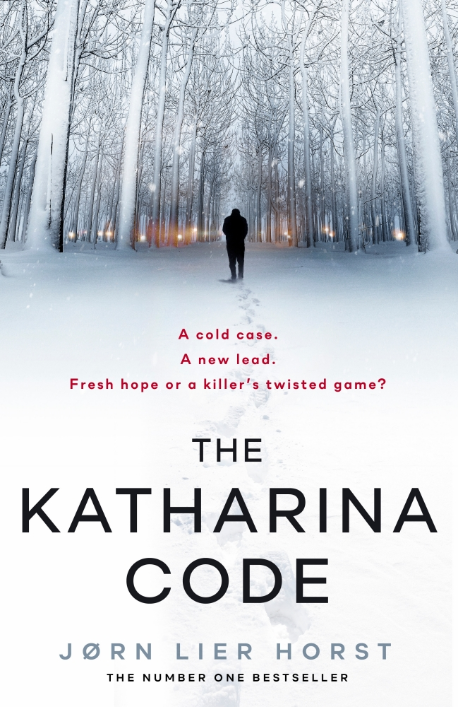
The Katharina Code, by contrast is, despite the need to decipher clues and break alibis, much more character driven. At the core of the book is a weekend which the detective spends with the suspect in an isolated cabin in the woods. The two know each other socially and, though it becomes increasingly clear to both that this is an exercise in psychological interrogation, the murders are not addressed directly. Instead, detective and suspect have long conversations about what might drive somebody to murder and the effect that this is likely to have on them. There is a sense of real physical danger (the suspect is hiding a gun in the cabin) but the tension is mostly psychological, ramping up to a violent climax. By then, both the police and an investigative reporter have found the evidence they need to prove the suspect is the killer but that is irrelevant to the two men playing mind games in the gloom of the Norwegian forests.
Hannah has written an archetypal English country house mystery set in Combingham Hall.
No one could have disputed that this was a fine and handsome building. It was surrounded by all one might wish for: attractive lawned gardens and, further from the house, a lake, a tennis court, two cottages, an orchard and a substantial wooded area.
Horst, by contrast, is firmly rooted in the world of Scandi noir.
After walking for 10 minutes Wisting spotted the grey roof between the trees ahead of them. The cabin was situated on a level expanse of ground. Wisting was familiar with the history of the place. It had been a croft… The cabin consisted of a kitchen, living room and two bedrooms with bunk beds. Wisting ducked his head beneath the low doorway and headed for the bedroom he had used last time.
Despite the difference in approach and setting, significant elements of both stories are the same. A murder has been committed and the detectives seek out the murderer. Both detectives are motivated by a strong sense of justice. Wisting says:
“I like to think I contribute to bringing about justice. When someone takes another person’s life, they have to know someone will come after them and hold them accountable.”
Poirot’s view is similar:
“If he was murdered, we must not let his murderer escape justice.”
Both detectives have a certain sympathy for the murderers. Poirot, on learning that the killer will not hang, remarks:
“I concern myself only with bringing to light the facts of the case, and securing the guilty verdict for the criminal, not with the punishment that follows. I leave such considerations to a higher authority.”
Wisting tries to reassure the man he is about to arrest:
“No matter what happened, we can resolve things. It might look hopeless right now, but that’s what my job is – finding a solution to these matters.”
In both cases, as in all whodunnits, the criminal is not only identified, but the solution is unquestionable. There must be no doubt at all that the right person is being blamed for the crime.
Poirot and Wisting are both defined by their role. Although Wisting is given a family, he lives alone (he is a widower) and both detectives are to a degree outside of the situation that they are investigating. They represent external order imposed by society or the state, resolving the untidiness of our crimes and restoring our sense of safety and security.
Murder is, though we worry about today’s violence, still a break from normality. The whodunnit challenges the social order with what is often regarded as the ultimate crime and then, through the intervention of some priest-like figure, normality is restored. Whodunnits, even with multiple corpses and grisly deaths (though none of the deaths in these two is especially gruesome) are essentially reassuring. As the nights draw in, it’s time to sit down with a drink and a good murder story.
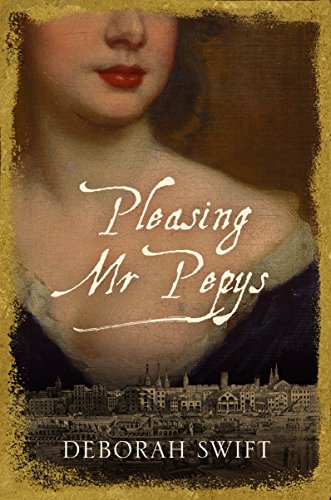
by TCW | Aug 14, 2018 | Book review
Deborah Swift has produced a remarkable work of historical fiction.
Samuel Pepys’ diaries provide an enormously detailed insight into the world of Restoration England and the personal life of a quite remarkable man. Swift has taken these diaries and woven them into a work of fiction that is part romance, part spy story, but most of all an evocation of life in what is technically Early Modern England.
The lovely thing about Early Modern is that much of it is recognisable in today’s world. Christopher Wren is planning St Paul’s Cathedral, Mrs Pepys is demanding new curtains and Pepys himself is setting out arrangements for the running of the Navy that will influence Admiralty procedures into the 20th century. People speak English, albeit with words we would not always understand, and London, though smaller than today, is already developing a geography we are familiar with. Whitehall may be White Hall and the site of a palace as well as many civil service offices and the Houses of Parliament, but it is still a centre of government and ‘South of the River’ still has the faintly unsavoury reputation it enjoyed until the gentrification of the late 20th century.
Much, though, has changed. We do not fear illness in the way that people naturally did in the days when surgery was performed without anaesthetic and antibiotics were unknown. Syphilis was common and sufferers were offered mercury treatment. I have never known the details of mercury treatment but, having read this book, I do. I rather wish I didn’t.
We see London through the eyes of Deb Willet, who has come up from Bromley – then a rural idyll – to be taken on as a lady’s maid by Elisabeth Pepys. “London,” her aunt informs her, “is quite different from Bromley or Bow” and Deb’s first sight of the place takes us directly into the noise and bustle of a city rebuilding after the horrendous fire.
Swift’s ability to pull us directly into Pepys’ London is, for me, the best thing about the book. This is not, though, a history book and a plot is called for. Here Swift has undertaken a tricky task because Deb (like most of the major characters in the story) was a real person who often featured in Pepys’ diary and Swift has set herself the task of telling a story that fits all the recorded facts. And what a story it is! Spies, murder, stolen secret plans and an explosion in the Royal Dockyards. And, of course, a romance.
I felt myself shifting between genres. Surely Lord Bruncker, President of the Royal Society, didn’t have a mistress who was a spy for the Dutch? Wikipedia assures me that he might well have, in which case I suppose she might have done the odd bit of assassination on the side. It brought me out of the quaint world of Deb’s London with a start, but it could have happened and it certainly kept me turning the pages.
Deb finds a young man. There is a whole science in Hollywood devoted to the business of arranging for heroine and beau to meet: Swift has Jem save Deb twice – once from attack by a dog and once when she is caught in the crush of a street riot. It’s smoothly done and the budding relationship is nicely, if predictably, handled. And then, suddenly, it’s not predictable at all as the two are separated by their attitudes to the Civil War. Jem supported the Parliamentarians, while Deb’s family were all Royalists. We get a glimpse of the way that the war had split society and how fragile the peace still was.
[SPOILERS in this paragraph. If you don’t want to know if we have a happy ending, skip ahead.] There’s another sub-plot where Deb is trying to find the mother who abandoned her as a child. It does make for some very busy plotting with a series of unlikely coincidences finally bringing Deb and Jem and her mother together, foiling the Dutch and providing a happy ending. (An end-note tells us that everybody died young, but then it was the 17th century and most people did.) The coincidences seem a bit pat to me, but Dickens got away with worse and no one seems to hold that against him.
For me, the busy plotting sometimes got in the way of enjoying the history. There are so many things going on that ‘What happened next?’ can get in the way of an appreciation of what we are experiencing now. But it’s stories that keep people reading and Swift spins an excellent tale. The characters, too are just fabulous and utterly believable. Pepys is particularly interesting, part avuncular employer, part satyr. In these days of #metoo, Swift walks a very fine line between suggesting that Pepys is basically a decent man and making it clear that his attitude to women, whilst perhaps more acceptable then than now, was amoral and deeply damaging to many of them (including his wife whose misery – well-recoded in the diaries – is sympathetically drawn).
If the magic, for me, was sometimes lost as we jumped from a description of a shopping trip to a quick aside into espionage with a rushed meeting with her young man (disapproved of by Elisabeth, of course) and then back to an account of supper in the Pepys household, at least there was magic to lose.
Overall, this was a wonderful book and one which, thanks in part to the constant twists and turns of the plot, is likely to draw in even people who have no previous interest in the period.












